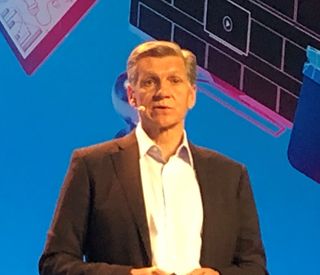CES: P&G Exec Sees Future Without Ads

The chief brand officer of the world’s biggest advertiser is looking future without ads.
Marc Pritchard, chief brand officer at Procter & Gamble, speaking at CES Wednesday said that technology was creating personalized and immersive experiences that could replace the kids of ads consumers try to avoid today.
“We can imagine a world without ads as we know them today through the intersection of multiple genres that create useful and interesting experiences while still reinforcing” the superiority of P&G’s products," Pritchard said.
Pritchard noted that companies like P&G are now operating in “a perpetual state of disruption” that affect the way it deals with consumers, retailers and media.
“If we thought the last decade was transformative, get ready for the exponential disruption coming in the next 10 years,” Pritchard said.
“So how do we deal with disruption? Lead it,” he said. “But at P&G, what we're trying to do is to lead constructive disruption and constructive is a carefully chosen word because it's one thing to disrupt and destroy value and the last decade is littered with value destructive disruptions. But the harder task and we view our job as market leaders is to disrupt in a way that drives growth and creates value for the consumers we serve.”
P&G is being disruptive about the way it creates new product and the way it markets them.
Broadcasting & Cable Newsletter
The smarter way to stay on top of broadcasting and cable industry. Sign up below
Pritchard said the company is disrupting the definition of the world’s biggest advertiser. “It's not who spends the most. It's who reaches the most people effectively and efficiently in a way that they want to be engaged.”
P&G has set about disrupting the marketing and media businesses.
“We’re also leading constructive disruption by reinventing brand building from wasteful mass marketing to precision one-to-one brand building on a mass scale through data analytics and digital technology,” Pritchard said.
“We reduced wasteful spending and reinvested it into better performing media, but where not done,” he said. P&G is looking for ways to avoid violent, unsafe and even illegally funded content.
The company has been a leader in calling for digital media transparency and third-party verified data on viewability and audience reach measurement.
“As we look to the next decade we want to create a responsible media supply chain with quality, transparency and respect for consumer data built in from the very start. We want a media supply chain that's good for consumers and good for business,” he said.
Internally P&G has been changing its relationship with its ad agencies, bringing more creative and media activity in-house. Pritchard estimated that nearly 30% of its media spending is already being planned in house.
P&G’s first-party data powers programmatic media buying to reach the people with the highest likelihood to buy its products and avoid annoying them by showing them the same ads too frequently.
For its Olay products, P&G was able to target audiences and reach 65 million high-potential users. That was more than the company reached using the old women 18 to 54 demographic and it spent 10% less, he said.
“The result is better consumers experiences and substantial savings and efficiencies,” he said.
Bringing creative in-house has had benefits. He said P&G’s Secret deodorant brand has no agency of record. Instead, campaigns are produced in house. One campaign was shot in Cincinnati, where P&G is based, for as little as one tenth the cost and was completed in one month versus five.
Jon has been business editor of Broadcasting+Cable since 2010. He focuses on revenue-generating activities, including advertising and distribution, as well as executive intrigue and merger and acquisition activity. Just about any story is fair game, if a dollar sign can make its way into the article. Before B+C, Jon covered the industry for TVWeek, Cable World, Electronic Media, Advertising Age and The New York Post. A native New Yorker, Jon is hiding in plain sight in the suburbs of Chicago.

